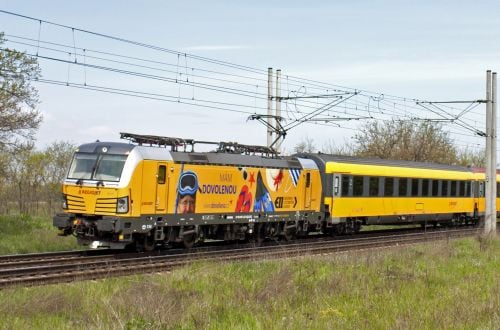Highlight of the Franz Josef Railway from Prague to Vienna

In the 1970s, the iconic rail route from Prague to Vienna, passing through southern Bohemia, lost its primary importance. However, today, it remains one of Central Europe’s most captivating train journeys. My partner and I chose to travel the entire Emperor Franz Joseph Railway leisurely earlier this month, foregoing the swift Railjet services. We aimed to experience the less-traveled expanse of southern Bohemia, recreating a slow-travel ambiance reminiscent of the Habsburg era.
In 1873, Vienna hosted the World Fair while commemorating Emperor Franz Joseph’s 25-year reign. The newly inaugurated railway connecting Bohemia to the Austrian capital bore the monarch’s name and served as the preferred route for travelers from Prague to Vienna, particularly those eager to attend the World Fair before its conclusion on October 31, 1873. During that time, four daily trains traversed the entire length of the Franz Joseph Railway from Prague to Vienna.
Embarking on a sunny early October day from Prague aboard a regional train bound for Tábor marked the start of our cross-border journey, involving multiple train transfers and an unexpected minibus ride. Our route initially passed through Prague’s suburbs, freight yards, and container depots, finally reaching the open countryside beyond Hostivař. We encountered a series of winding switchbacks, traversing ridges and briefly skimming the Sázava Valley at Čerčany. On this journey, we stumbled upon a charming mini-bistro tucked away in the rear carriage of the train, transforming Sunday lunch into a delightful affair featuring Czech goulash soup and local beer.
Forests and Lakes
Commencing from Tábor, the Franz Joseph Railway follows the tranquil Lužnice Valley upstream into Austria. A significant portion of the railway is single-track, resulting in a leisurely pace. Electrification of the line extends no further than Veselí nad Lužnicí. At this point, we switched to a local train—a quaint duo of antiquated carriages propelled by a noisy diesel engine. With the windows down, we savored a serene Sunday afternoon journey through Bohemia’s rural landscapes. The scenery was irresistibly picturesque, diminishing our hopes of reaching Vienna by evening.
Unplanned Memories
As the train paused by a lake at Vikov, the temptation to disembark arose. However, the prospect of finding accommodations seemed remote, so we decided to stay aboard. We glided past reedy marshlands adorned with alder and willow trees, dilapidated barns overgrown with weeds, majestic storks presiding over water meadows, and lakes surrounded by quaint wooden boathouses. Our next stop was at Trebon Lazne, where the station building boasted an elegant white colonnade. This stop looked promising, leading us to opt for an impromptu overnight stay.
A pleasant 10-minute stroll from the station led us into the heart of Třeboň, a charming small town characterized by a picturesque square, complete with its castle, and a serene park alongside a tranquil lake. Small-town Bohemia is renowned for hosting some of Europe’s most idyllic communities, and our spontaneous arrival in Třeboň turned out to be a stroke of luck. In the October evening sunshine, as summer gracefully transitioned into autumn, we indulged in the appealing dining options offered by local restaurants, prominently featuring an abundance of carp and trout sourced from nearby lakes.
Exploring Třeboň
Arriving in Třeboň during the mid-afternoon and with no urgency to leave the next morning allowed us to delve into the history of this small town. It played a pivotal role in serving the surrounding rural region, boasting an aquaculture tradition spanning several centuries, with the local economy centered around freshwater fish cultivation.
Into Austria
The next day, back on the station platform, we signaled to halt the local train at Třeboň Lázně. The station functioned as a request stop. The train conductor checked our Interrail passes and informed us that no trains would be running across the Austrian border that day. “Not to worry,” he assured us. “There will be a bus in place.”
While the mention of a rail replacement bus service might concern many travelers, we adapted to such changes. Approaching České Velenice, an announcement declared the train’s termination, and all passengers were required to disembark. Inside the station building, the neatly dressed station manager asked us if we were headed to Austria and directed us to wait by the roadside. It turned out we were the only passengers embarking on this cross-border adventure. An eight-minute ride in a white minibus took us to Gmünd in Austria, where a double-decker train awaited us to continue our journey to Vienna.
A Serene Journey through Austria
The leisurely journey through the Woodland Quarter, from Gmünd to Vienna, offered a serene introduction to Austria. This two-and-a-quarter-hour voyage gently wound eastward through forested hilly terrain en route to the capital. Transitioning from woodlands, we passed vineyards, fields adorned with sunflowers, and pumpkins. To the left, the picturesque walled town of Eggenburg gracefully perched on a granite plateau. We then traced the Schmida Valley downward towards the Danube.
Crossing the Danube at Tulln was a dramatic spectacle, followed by a downstream journey along the river’s right bank toward Vienna. As we traversed communities historically wary of the formidable river due to recurrent flooding, certain


